SSANGYONG MUSSO 2003 User Guide
Manufacturer: SSANGYONG, Model Year: 2003, Model line: MUSSO, Model: SSANGYONG MUSSO 2003Pages: 1574, PDF Size: 26.41 MB
Page 11 of 1574
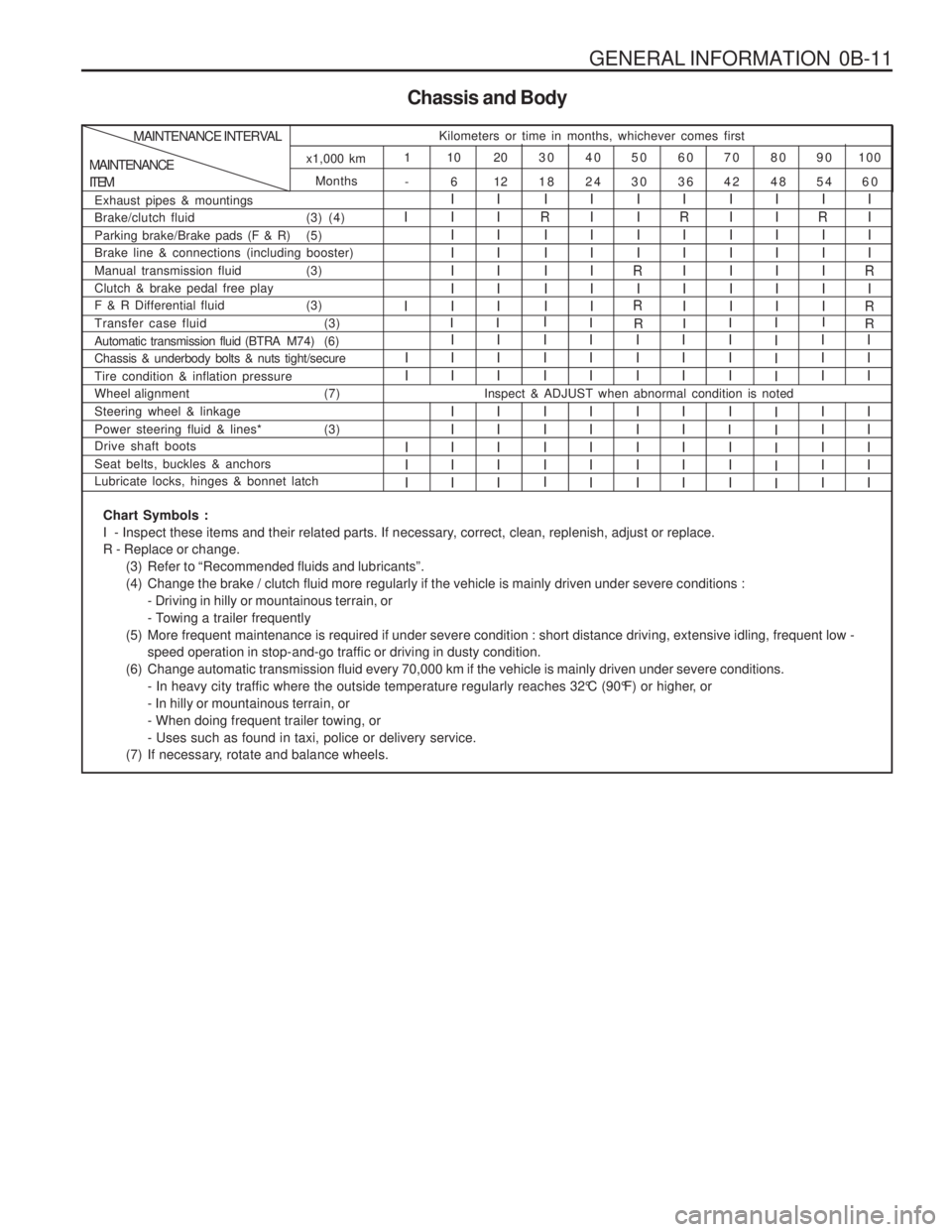
GENERAL INFORMATION 0B-11
Chassis and Body
Months -
MAINTENANCE ITEMMAINTENANCE INTERVAL
Kilometers or time in months, whichever comes first
100
90
80
70
60
50
40
30
20
10
1
60
54
48
42
36
30
24
18
12
6
x1,000 km
Exhaust pipes & mountings
Brake/clutch fluid (3) (4)
Parking brake/Brake pads (F & R) (5) Brake line & connections (including booster)
Manual transmission fluid (3)Clutch & brake pedal free play
F & R Differential fluid (3)
I I I IIIIIIIIIIIII I
R
IIIII IIIIIII IIII
R I
R I
R
IIIII IIIIIIIIIIIIII I
R
IIIII IIII
R I
R
Automatic transmission fluid (BTRA M74) (6) Chassis & underbody bolts & nuts tight/secure Tire condition & inflation pressure
Wheel alignment (7) Steering wheel & linkage
Power steering fluid & lines* (3) Drive shaft boots Seat belts, buckles & anchors Lubricate locks, hinges & bonnet latchI II I IIII III I IIII IIII I III I
I II I IIII III I IIIIIII I IIII III II II III I IIIIIII I IIII
Transfer case fluid (3)
RI R
I
I
I
I I I II IIII I IIII
Inspect & ADJUST when abnormal condition is noted
II I
Chart Symbols :
I - Inspect these items and their related parts. If necessary, correct, clean, replenish, adjust or replace.R - Replace or change.
(3) Refer to “Recommended fluids and lubricants”.
(4) Change the brake / clutch fluid more regularly if the vehicle is mainly driven under severe conditions :- Driving in hilly or mountainous terrain, or
- Towing a trailer frequently
(5) More frequent maintenance is required if under severe condition : short distance driving, extensive idling, frequent low - speed operation in stop-and-go traffic or driving in dusty condition.
(6) Change automatic transmission fluid every 70,000 km if the vehicle is mainly driven under severe conditions. - In heavy city traffic where the outside temperature regularly reaches 32°C (90°F) or higher, or- In hilly or mountainous terrain, or- When doing frequent trailer towing, or- Uses such as found in taxi, police or delivery service.
(7) If necessary, rotate and balance wheels.
Page 12 of 1574
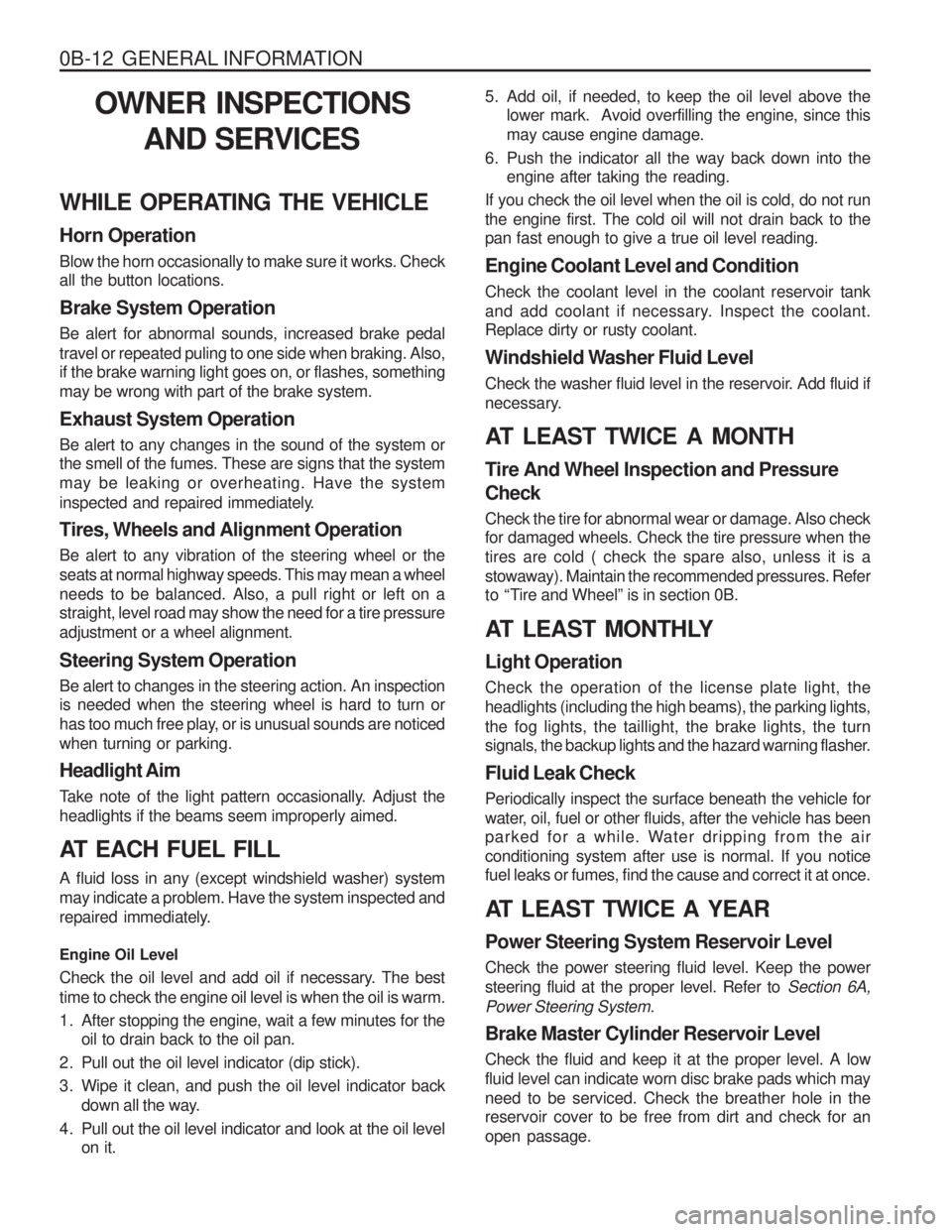
0B-12 GENERAL INFORMATIONOWNER INSPECTIONS AND SERVICES
WHILE OPERATING THE VEHICLE Horn Operation Blow the horn occasionally to make sure it works. Check all the button locations. Brake System Operation Be alert for abnormal sounds, increased brake pedal travel or repeated puling to one side when braking. Also, if the brake warning light goes on, or flashes, something may be wrong with part of the brake system. Exhaust System Operation Be alert to any changes in the sound of the system or the smell of the fumes. These are signs that the system may be leaking or overheating. Have the system
inspected and repaired immediately. Tires, Wheels and Alignment Operation Be alert to any vibration of the steering wheel or the seats at normal highway speeds. This may mean a wheelneeds to be balanced. Also, a pull right or left on a straight, level road may show the need for a tire pressure adjustment or a wheel alignment. Steering System Operation Be alert to changes in the steering action. An inspection is needed when the steering wheel is hard to turn or
has too much free play, or is unusual sounds are noticedwhen turning or parking. Headlight Aim
Take note of the light pattern occasionally. Adjust the headlights if the beams seem improperly aimed.
AT EACH FUEL FILL A fluid loss in any (except windshield washer) system may indicate a problem. Have the system inspected and
repaired immediately. Engine Oil Level
Check the oil level and add oil if necessary. The best time to check the engine oil level is when the oil is warm.
1. After stopping the engine, wait a few minutes for the oil to drain back to the oil pan.
2. Pull out the oil level indicator (dip stick).
3. Wipe it clean, and push the oil level indicator back down all the way.
4. Pull out the oil level indicator and look at the oil level on it. 5. Add oil, if needed, to keep the oil level above the
lower mark. Avoid overfilling the engine, since this may cause engine damage.
6. Push the indicator all the way back down into the engine after taking the reading.
If you check the oil level when the oil is cold, do not runthe engine first. The cold oil will not drain back to the pan fast enough to give a true oil level reading. Engine Coolant Level and Condition Check the coolant level in the coolant reservoir tank
and add coolant if necessary. Inspect the coolant. Replace dirty or rusty coolant.
Windshield Washer Fluid Level
Check the washer fluid level in the reservoir. Add fluid if
necessary.
AT LEAST TWICE A MONTH Tire And Wheel Inspection and Pressure Check Check the tire for abnormal wear or damage. Also check for damaged wheels. Check the tire pressure when the tires are cold ( check the spare also, unless it is astowaway). Maintain the recommended pressures. Refer
to “Tire and Wheel” is in section 0B.
AT LEAST MONTHLY Light Operation Check the operation of the license plate light, the headlights (including the high beams), the parking lights,the fog lights, the taillight, the brake lights, the turn
signals, the backup lights and the hazard warning flasher. Fluid Leak Check Periodically inspect the surface beneath the vehicle for
water, oil, fuel or other fluids, after the vehicle has been
parked for a while. Water dripping from the air conditioning system after use is normal. If you notice fuel leaks or fumes, find the cause and correct it at once.
AT LEAST TWICE A YEAR Power Steering System Reservoir Level Check the power steering fluid level. Keep the power steering fluid at the proper level. Refer to Section 6A,
Power Steering System. Brake Master Cylinder Reservoir Level Check the fluid and keep it at the proper level. A low fluid level can indicate worn disc brake pads which mayneed to be serviced. Check the breather hole in the reservoir cover to be free from dirt and check for an open passage.
Page 13 of 1574
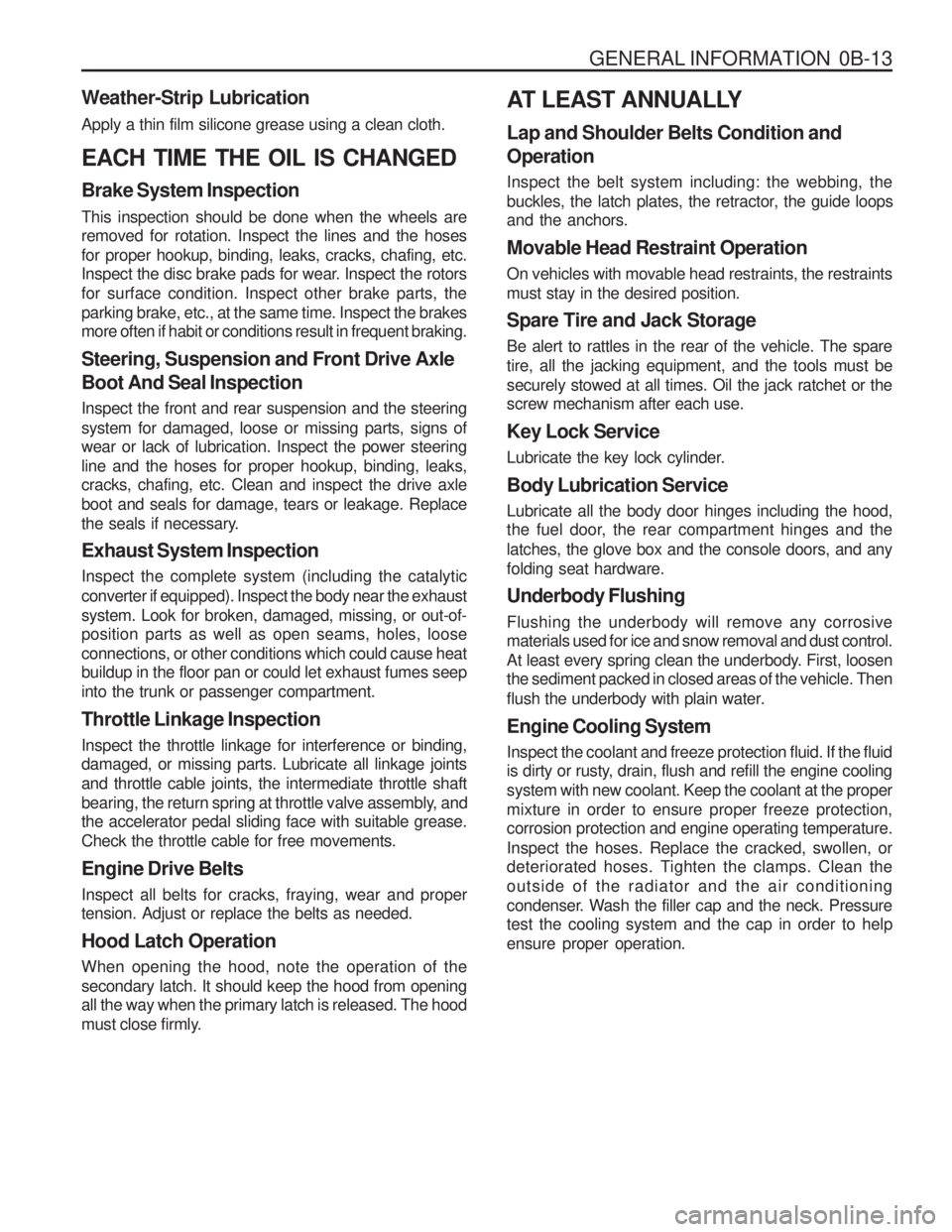
GENERAL INFORMATION 0B-13
Weather-Strip Lubrication Apply a thin film silicone grease using a clean cloth. EACH TIME THE OIL IS CHANGED Brake System Inspection This inspection should be done when the wheels are removed for rotation. Inspect the lines and the hoses for proper hookup, binding, leaks, cracks, chafing, etc.
Inspect the disc brake pads for wear. Inspect the rotors for surface condition. Inspect other brake parts, theparking brake, etc., at the same time. Inspect the brakes more often if habit or conditions result in frequent braking. Steering, Suspension and Front Drive Axle Boot And Seal Inspection Inspect the front and rear suspension and the steering system for damaged, loose or missing parts, signs of wear or lack of lubrication. Inspect the power steering line and the hoses for proper hookup, binding, leaks, cracks, chafing, etc. Clean and inspect the drive axle boot and seals for damage, tears or leakage. Replace
the seals if necessary. Exhaust System Inspection Inspect the complete system (including the catalytic converter if equipped). Inspect the body near the exhaustsystem. Look for broken, damaged, missing, or out-of- position parts as well as open seams, holes, loose connections, or other conditions which could cause heat buildup in the floor pan or could let exhaust fumes seep into the trunk or passenger compartment. Throttle Linkage Inspection Inspect the throttle linkage for interference or binding, damaged, or missing parts. Lubricate all linkage joints and throttle cable joints, the intermediate throttle shaft
bearing, the return spring at throttle valve assembly, and the accelerator pedal sliding face with suitable grease. Check the throttle cable for free movements. Engine Drive Belts Inspect all belts for cracks, fraying, wear and proper tension. Adjust or replace the belts as needed. Hood Latch Operation When opening the hood, note the operation of the secondary latch. It should keep the hood from opening all the way when the primary latch is released. The hood
must close firmly. AT LEAST ANNUALLY Lap and Shoulder Belts Condition and Operation Inspect the belt system including: the webbing, the
buckles, the latch plates, the retractor, the guide loops and the anchors. Movable Head Restraint Operation On vehicles with movable head restraints, the restraints must stay in the desired position. Spare Tire and Jack Storage Be alert to rattles in the rear of the vehicle. The spare tire, all the jacking equipment, and the tools must besecurely stowed at all times. Oil the jack ratchet or the screw mechanism after each use. Key Lock Service
Lubricate the key lock cylinder. Body Lubrication Service Lubricate all the body door hinges including the hood,
the fuel door, the rear compartment hinges and the latches, the glove box and the console doors, and anyfolding seat hardware. Underbody Flushing Flushing the underbody will remove any corrosive materials used for ice and snow removal and dust control.
At least every spring clean the underbody. First, loosen the sediment packed in closed areas of the vehicle. Then
flush the underbody with plain water. Engine Cooling System Inspect the coolant and freeze protection fluid. If the fluid
is dirty or rusty, drain, flush and refill the engine cooling system with new coolant. Keep the coolant at the propermixture in order to ensure proper freeze protection, corrosion protection and engine operating temperature. Inspect the hoses. Replace the cracked, swollen, or
deteriorated hoses. Tighten the clamps. Clean the outside of the radiator and the air conditioning
condenser. Wash the filler cap and the neck. Pressure test the cooling system and the cap in order to help ensure proper operation.
Page 14 of 1574
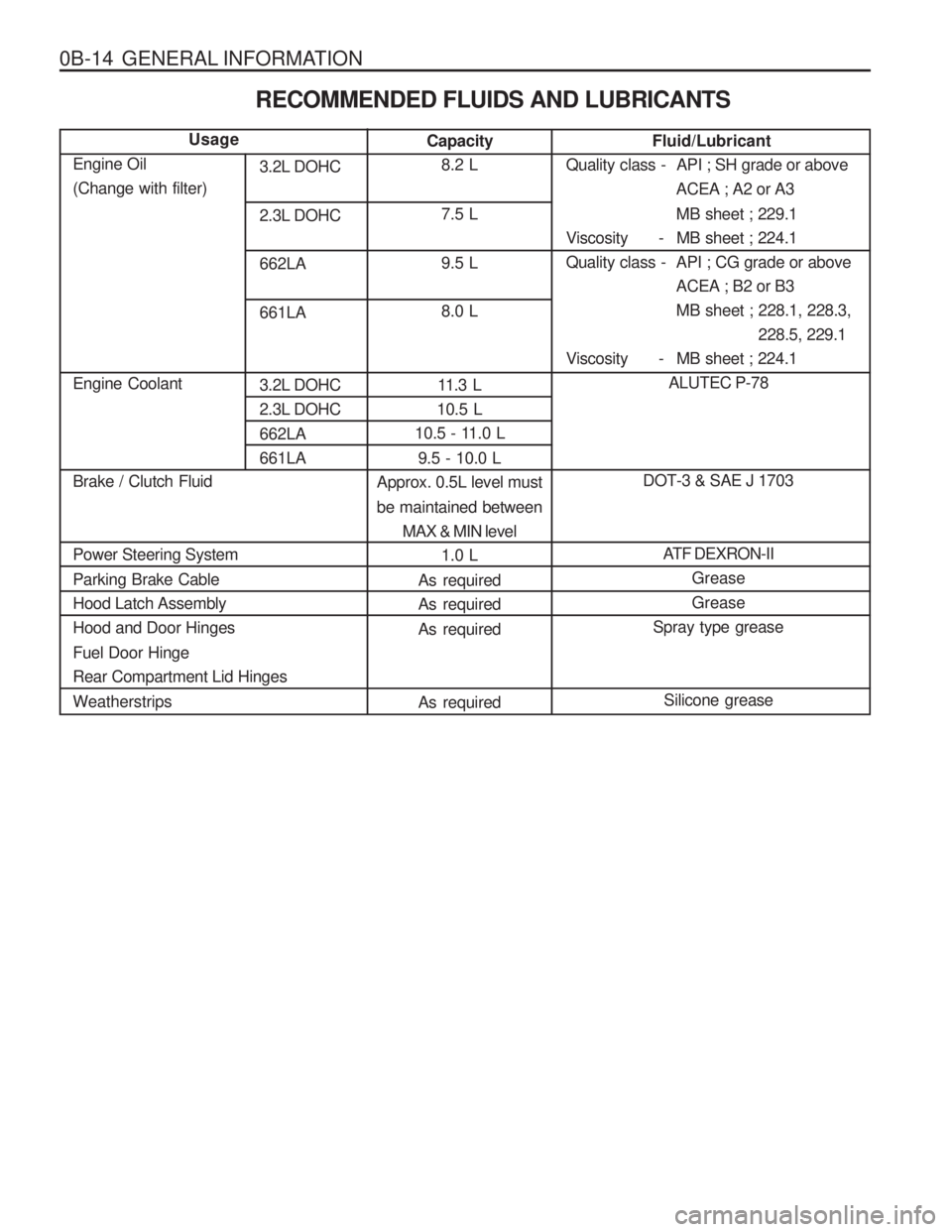
0B-14 GENERAL INFORMATIONUsage
Engine Oil (Change with filter) Engine Coolant Brake / Clutch Fluid Power Steering System Parking Brake Cable Hood Latch AssemblyHood and Door Hinges Fuel Door Hinge Rear Compartment Lid Hinges Weatherstrips
RECOMMENDED FLUIDS AND LUBRICANTS
Capacity 8.2 L 7.5 L9.5 L 8.0 L
11.3 L
10.5 L
10.5 - 11.0 L
9.5 - 10.0 L
Approx. 0.5L level must be maintained between MAX & MIN level 1.0 L
As required As required As required As required Fluid/Lubricant
Quality class - API ; SH grade or above
ACEA ; A2 or A3 MB sheet ; 229.1
Viscosity - MB sheet ; 224.1
Quality class - API ; CG grade or above ACEA ; B2 or B3MB sheet ; 228.1, 228.3, 228.5, 229.1
Viscosity - MB sheet ; 224.1 ALUTEC P-78
DOT-3 & SAE J 1703 ATF DEXRON-II Grease Grease
Spray type grease
Silicone grease
3.2L DOHC 2.3L DOHC 662LA 661LA 3.2L DOHC 2.3L DOHC 662LA 661LA
Page 15 of 1574
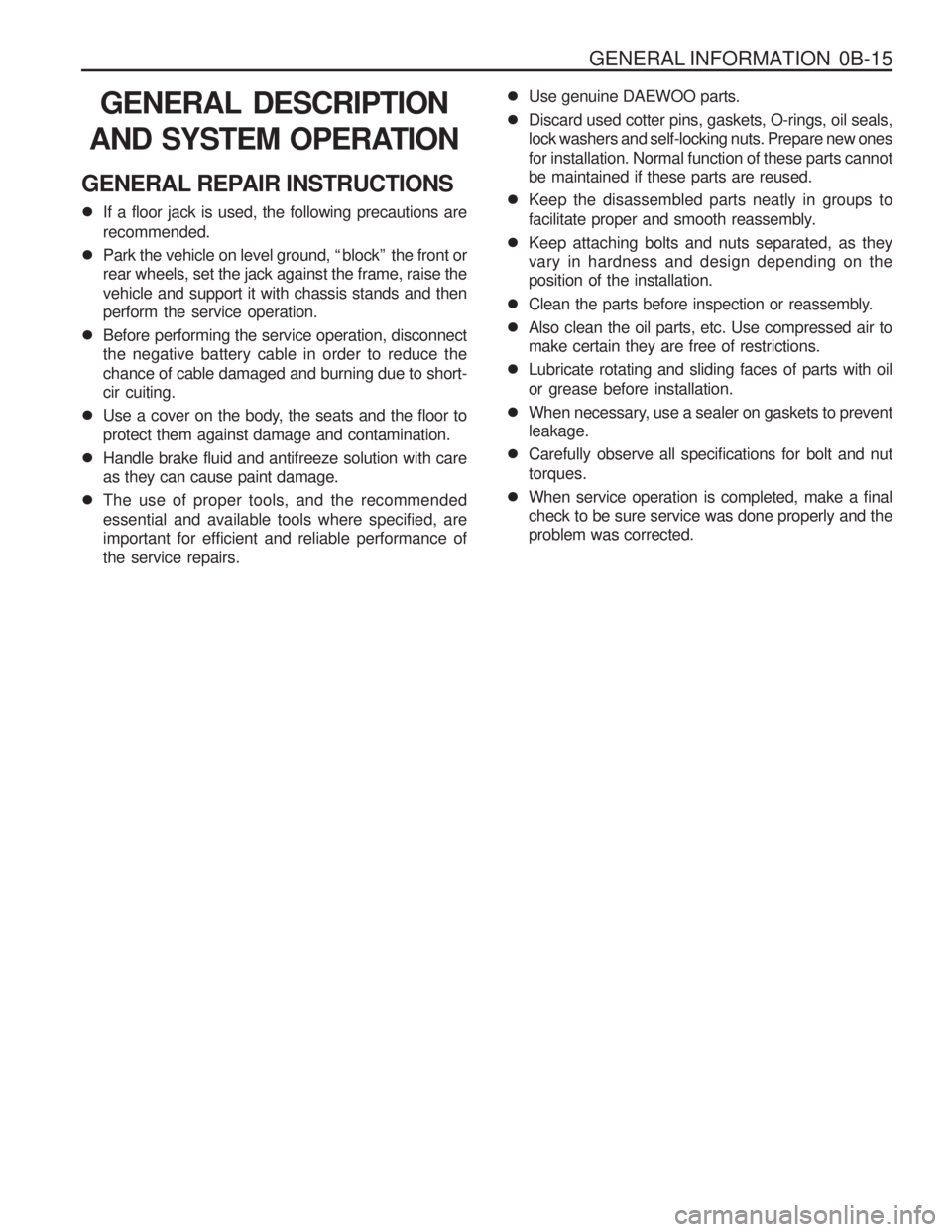
GENERAL INFORMATION 0B-15
GENERAL DESCRIPTION
AND SYSTEM OPERATION
GENERAL REPAIR INSTRUCTIONS
� If a floor jack is used, the following precautions are recommended.
� Park the vehicle on level ground, “ block” the front or rear wheels, set the jack against the frame, raise the vehicle and support it with chassis stands and then perform the service operation.
� Before performing the service operation, disconnectthe negative battery cable in order to reduce the chance of cable damaged and burning due to short- cir cuiting.
� Use a cover on the body, the seats and the floor to protect them against damage and contamination.
� Handle brake fluid and antifreeze solution with care as they can cause paint damage.
� The use of proper tools, and the recommended essential and available tools where specified, are important for efficient and reliable performance of the service repairs. �
Use genuine DAEWOO parts.
� Discard used cotter pins, gaskets, O-rings, oil seals, lock washers and self-locking nuts. Prepare new ones for installation. Normal function of these parts cannot be maintained if these parts are reused.
� Keep the disassembled parts neatly in groups to
facilitate proper and smooth reassembly.
� Keep attaching bolts and nuts separated, as they vary in hardness and design depending on theposition of the installation.
� Clean the parts before inspection or reassembly.
� Also clean the oil parts, etc. Use compressed air tomake certain they are free of restrictions.
� Lubricate rotating and sliding faces of parts with oil or grease before installation.
� When necessary, use a sealer on gaskets to prevent leakage.
� Carefully observe all specifications for bolt and nut torques.
� When service operation is completed, make a final check to be sure service was done properly and theproblem was corrected.
Page 16 of 1574

0B-16 GENERAL INFORMATIONVEHICLE IDENTIFICATION NUMBER SYSTEM
K P T P 0 A 1 9 S W P 122357
12~17.Production Serial Number: 000001- 999999
11.Plant Code P : PyongTaek Plant
10.Model Year
M : 1991
N : 1992
P : 1993
R : 1994
S : 1995
T : 1996
V : 1997
W : 1998X : 1999 Y : 2000
9. Check Digit Constant “S”
8. Engine Type 3 : 2299cc, In-line 4Cylinder, Diesel (OM601)
4 : 2874cc, In-line 5Cylinder, Diesel (OM602)
8 : 1998cc, In-line 4Cylinder, Gasoline (E20)
6 : 2295cc, In-line 4Cylinder, Gasoline (E23)
9 : 3199cc, In-line 6Cylinder, Gasoline (E32)
A : 2299cc, In-line 4Cylinder, Diesel (OM601)
B : 2874cc, In-line 5Cylinder, Diesel (OM602)
C : 2299cc, In-line 4Cylinder, Diesel (SY662LA)
D : 2874cc, In-line 5Cylinder, Diesel (SY662LA)
7. Restraint System 0 : NO Seat Belt,1 : 3-Point Seat Belts, 2 : 2-Point Seat Belts
6 . Trim Level A : Standard, B : Deluxe, C : Super Deluxe
5. Body Type
0 : 5-Door1 : 4-Door 2 : 3-Door
4. Line Models P : Musso, LHD, R : Musso, RHD
3. Vehicle Type
T (Passengr Cars)
2. Name of Mamufacturer : P
1. Nation : K
Page 17 of 1574
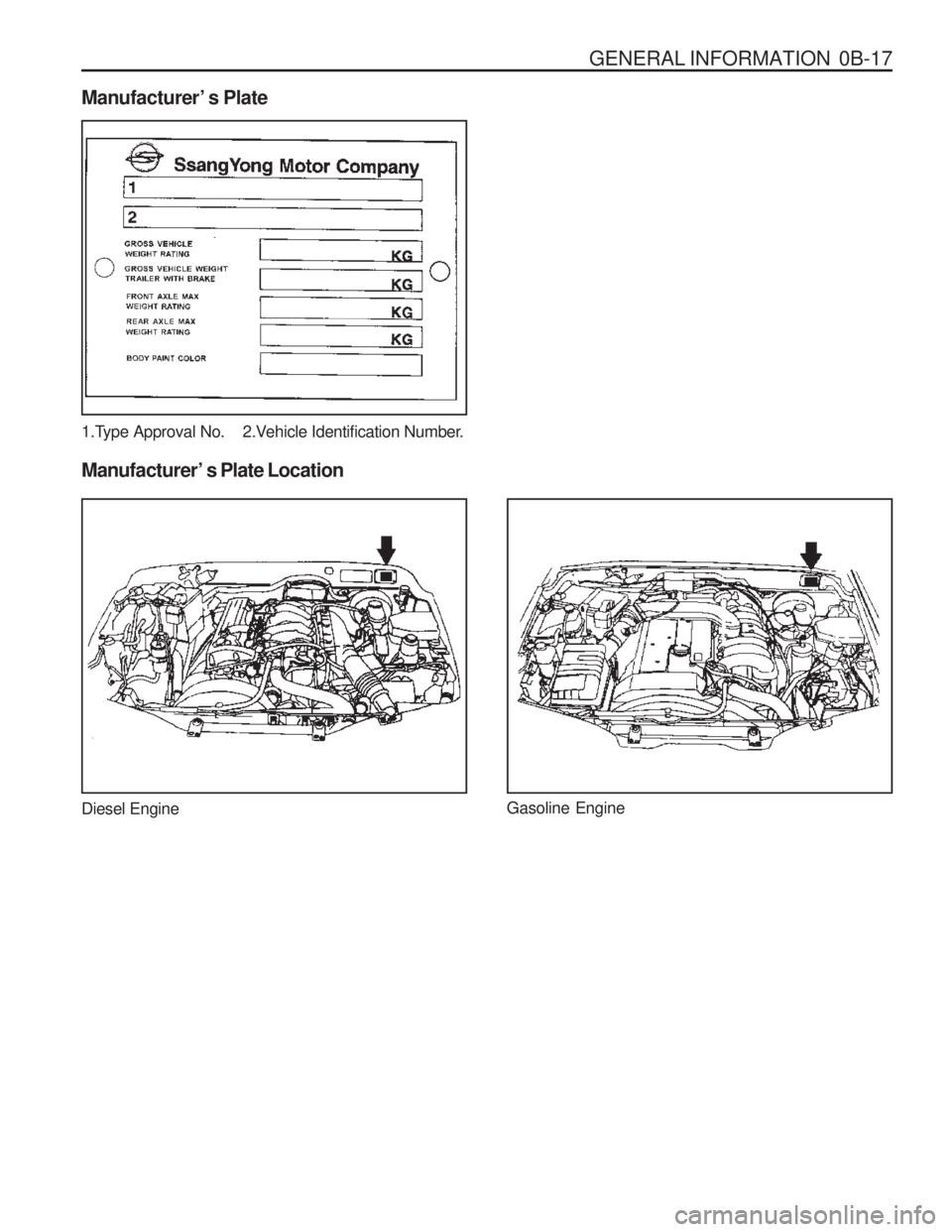
GENERAL INFORMATION 0B-17
Manufacturer’ s Plate
Manufacturer’ s Plate Location
1.Type Approval No. 2.Vehicle Identification Number.
Diesel Engine
Gasoline Engine
Page 18 of 1574
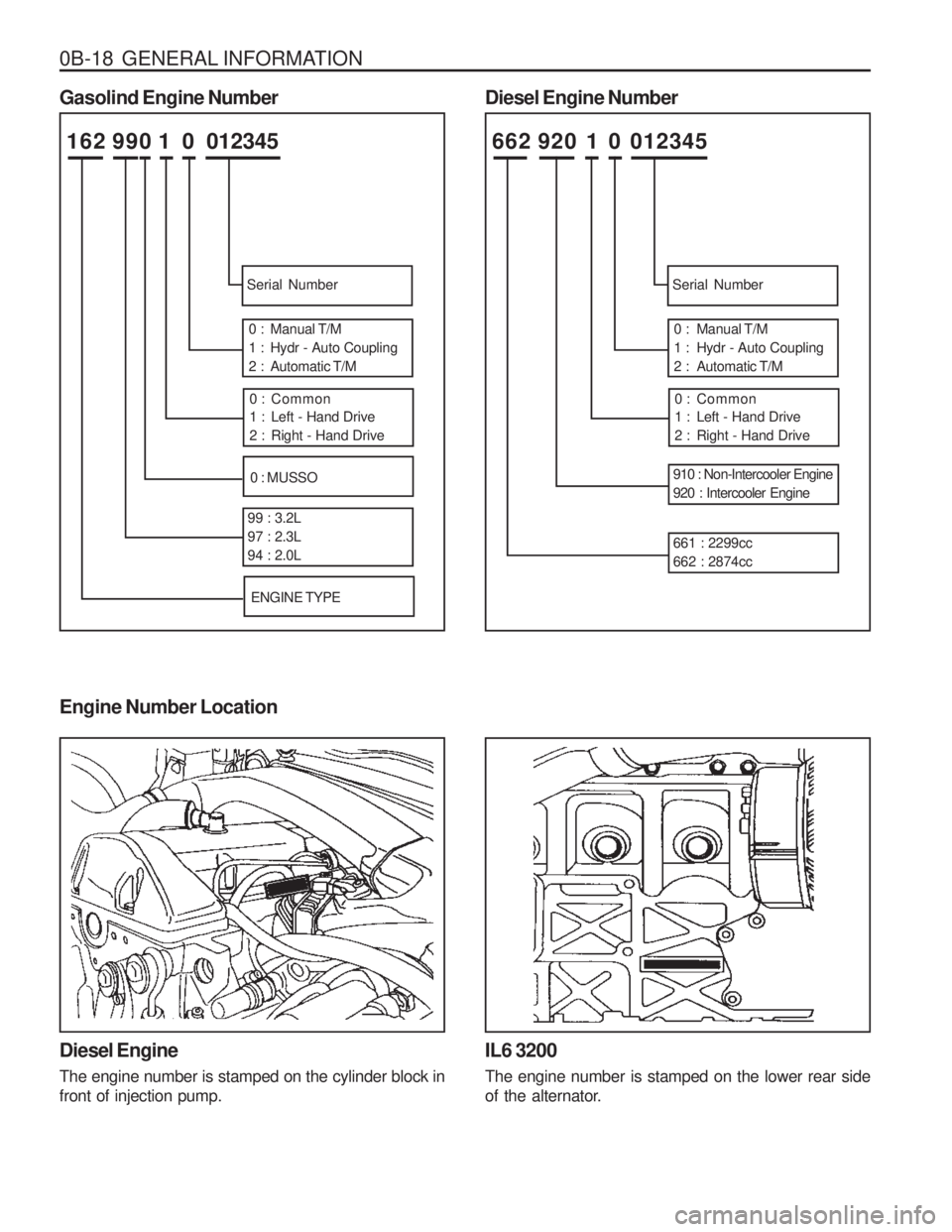
0B-18 GENERAL INFORMATION
Engine Number Location Diesel Engine The engine number is stamped on the cylinder block in front of injection pump.
IL6 3200 The engine number is stamped on the lower rear side
of the alternator.
Gasolind Engine Number1 6 2 9 9 0 1 0 012345
Serial Number
0 : Manual T/M
1 : Hydr - Auto Coupling
2 : Automatic T/M
99 : 3.2L 97 : 2.3L94 : 2.0L
0 : Common
1 : Left - Hand Drive
2 : Right - Hand Drive
ENGINE TYPE
0 : MUSSO
Diesel Engine Number 662 920 1 0 012345
Serial Number
0 : Manual T/M
1 : Hydr - Auto Coupling
2 : Automatic T/M
910 : Non-Intercooler Engine 920 : Intercooler Engine
0 : Common
1 : Left - Hand Drive
2 : Right - Hand Drive
661 : 2299cc662 : 2874cc
Page 19 of 1574
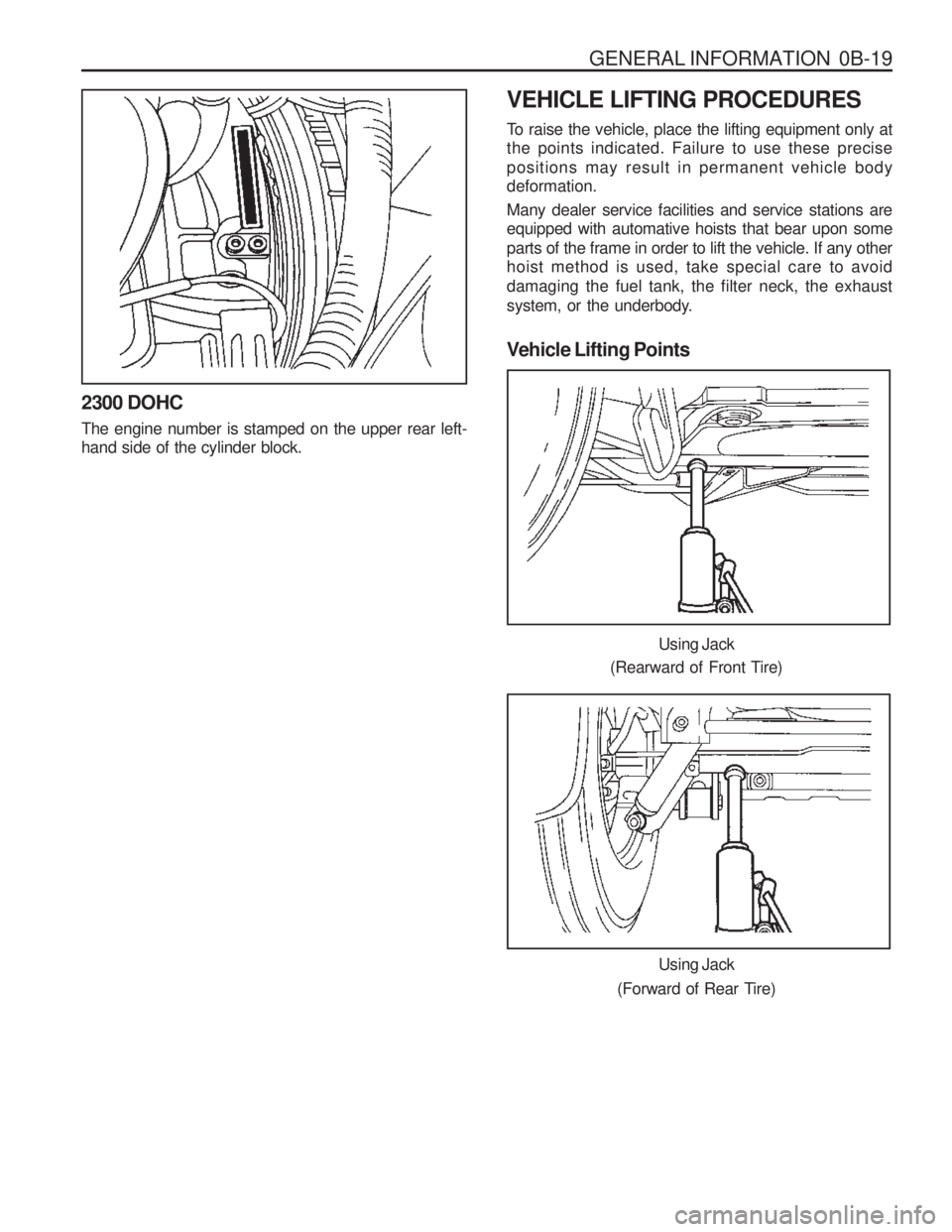
GENERAL INFORMATION 0B-19
VEHICLE LIFTING PROCEDURES
To raise the vehicle, place the lifting equipment only at the points indicated. Failure to use these precise positions may result in permanent vehicle body deformation. Many dealer service facilities and service stations are equipped with automative hoists that bear upon some parts of the frame in order to lift the vehicle. If any other hoist method is used, take special care to avoid damaging the fuel tank, the filter neck, the exhaust
system, or the underbody.
Vehicle Lifting Points
Using Jack
(Rearward of Front Tire)
Using Jack
(Forward of Rear Tire)
2300 DOHC The engine number is stamped on the upper rear left- hand side of the cylinder block.
Page 20 of 1574
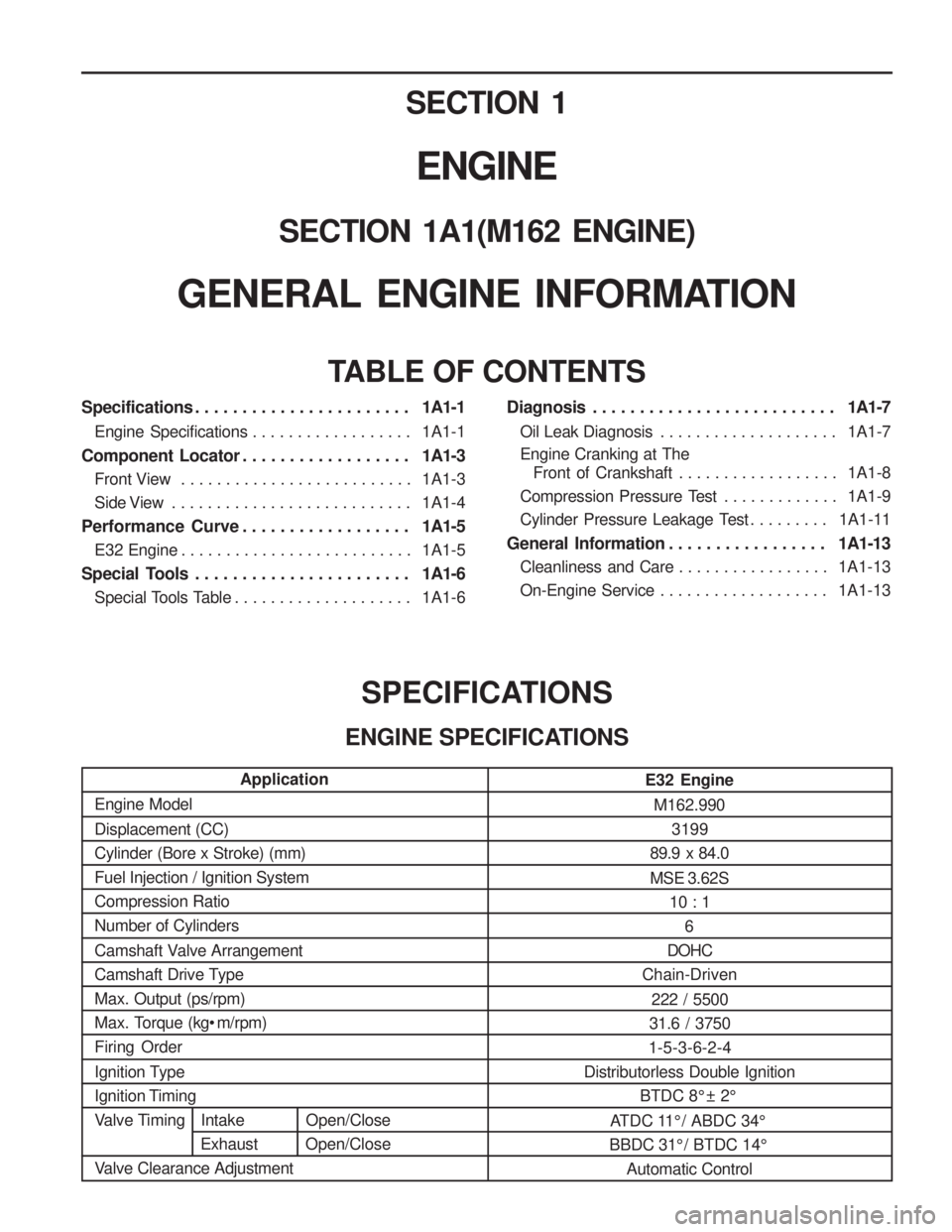
SECTION 1
ENGINE
SECTION 1A1(M162 ENGINE)
GENERAL ENGINE INFORMATION
Specifications . . . . . . . . . . . . . . . . . . . . . . . 1A1-1
Engine Specifications . . . . . . . . . . . . . . . . . . 1A1-1
Component Locator . . . . . . . . . . . . . . . . . . 1A1-3
Front View . . . . . . . . . . . . . . . . . . . . . . . . . . 1A1-3
Side View . . . . . . . . . . . . . . . . . . . . . . . . . . . 1A1-4
Performance Curve . . . . . . . . . . . . . . . . . . 1A1-5
E32 Engine . . . . . . . . . . . . . . . . . . . . . . . . . . 1A1-5
Special Tools . . . . . . . . . . . . . . . . . . . . . . . 1A1-6
Special Tools Table . . . . . . . . . . . . . . . . . . . . 1A1-6Diagnosis . . . . . . . . . . . . . . . . . . . . . . . . . .
1A1-7
Oil Leak Diagnosis . . . . . . . . . . . . . . . . . . . . 1A1-7
Engine Cranking at The Front of Crankshaft . . . . . . . . . . . . . . . . . . 1A1-8
Compression Pressure Test . . . . . . . . . . . . . 1A1-9
Cylinder Pressure Leakage Test . . . . . . . . . 1A1-11
General Information . . . . . . . . . . . . . . . . . 1A1-13
Cleanliness and Care . . . . . . . . . . . . . . . . . 1A1-13
On-Engine Service . . . . . . . . . . . . . . . . . . . 1A1-13
Application
Engine Model Displacement (CC) Cylinder (Bore x Stroke) (mm)Fuel Injection / Ignition SystemCompression RatioNumber of Cylinders
Camshaft Valve Arrangement
Camshaft Drive TypeMax. Output (ps/rpm)
Max. Torque (kg• m/rpm)Firing Order
Ignition Type
Ignition Timing
Valve Timing Intake Open/Close ExhaustOpen/Close
Valve Clearance Adjustment SPECIFICATIONS
ENGINE SPECIFICATIONS E32 EngineM162.990 3199
89.9 x 84.0
MSE 3.62S 10 : 1
6
DOHC
Chain-Driven
222 / 5500
31.6 / 3750
1-5-3-6-2-4
Distributorless Double Ignition BTDC 8° ± 2°
ATDC 11° / ABDC 34°
BBDC 31° / BTDC 14° Automatic Control
TABLE OF CONTENTS